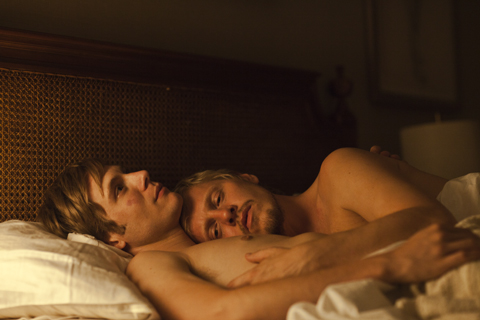
UNLIKELY PAIR Paul, a white-collar businessman, and Erik, a documentarian. |
Keep the Lights On is only one hour and 42 minutes long, but by the conclusion of this 2012 indie film by director Ira Sachs, you feel that you've known the main characters, Erik and Paul, for much longer. Told episodically over the course of 10 years, Keep the Lights On depicts Erik and Paul's difficult and wonderful love affair ("saga" might be a more appropriate word for their relationship), unflinchingly treating drug abuse, sex addiction, and co-dependency in shockingly relatable form.
That the widely praised film is a fictionalized account of Sachs's own heartbreaking relationship with literary agent and former drug addict Bill Clegg, based in part on Sachs's journals from the late 1990s and early 2000s, is not hard to believe. The script, co-written by Sachs and Mauricio Zacharias, is spare and largely authentic (though some dialogue feels ripped from a therapy session), while cinematography by Thimios Bakatakis feels simultaneously warm and voyeuristic. That the two lead actors could so fully embody their characters, offering brilliantly honest portrayals of physical intimacy (of both the loving and empty varieties) and drug use — that's more surprising.
Sachs credits the lack of rehearsal, a tactic he learned from director Sydney Pollack (Tootsie, Out of Africa), for the actors' natural performances. The director sat down for separate conversations with both Thure Lindhardt (Erik) and Zachary Booth (Paul), then sent them out on a real "date" — they saw Billy Elliot and went dancing. That was it. There were no official rehearsals.
"What that does is it creates an atmosphere of the unexpected," Sachs says on the phone from New York City. "It creates the possibility for the actor to primarily listen. They're not trying to process subtext . . . not trying to find meaning or motivation. They take things in truly for the first time." Because, of course, we rarely understand our own subconscious in the moment; acting from explicit motivation is "antithetical to how life works."
Keep the Lights On will be shown at SPACE Gallery on Wednesday, November 14, as part of the Normative Narratives film series organized by Portland resident Christopher Stiegler. (Director Sachs will be present at the screening and there will be a Q-and-A session afterward.) When I spoke to Stiegler in August, he described his desire to show cinematic "representations of gay men that aren't stereotypes." This film certainly succeeds in that regard.
Yes, Erik and Paul are gay. Yes, one subplot of the film deals with Erik's anxiety over his HIV status. Yes, the men meet through a casual-encounter-type phone-sex line. Yes, drug use (Paul is addicted to crack) is part of the world they live in. Perhaps these seem like urban-gay-male tropes. But Erik and Paul's sexuality isn't necessarily at the heart of this film. Their choices, their flaws, and their hungry mutual attraction, the ripple effects of their shortcomings — these are what Keep the Lights On is about. These are what make the film so worth watching.